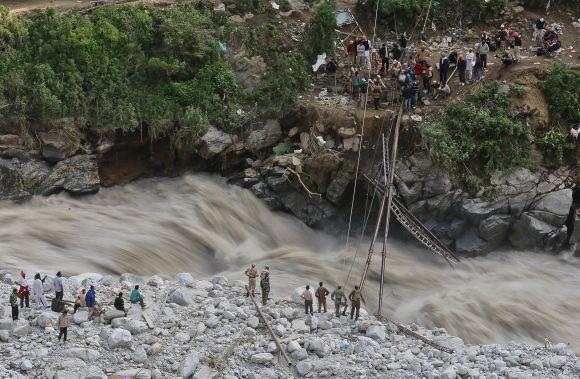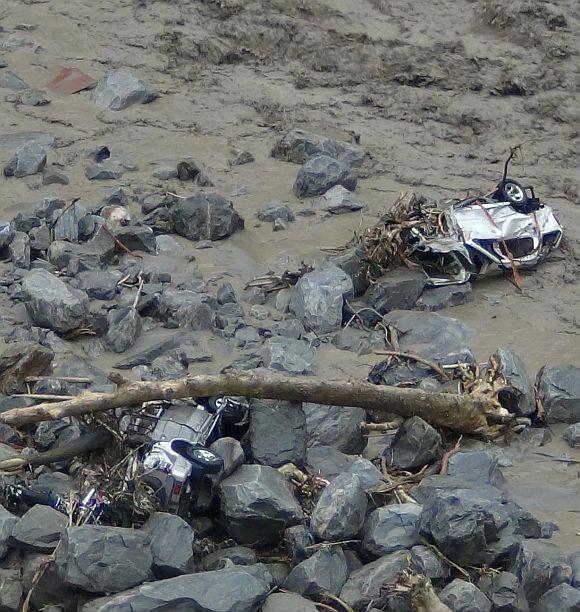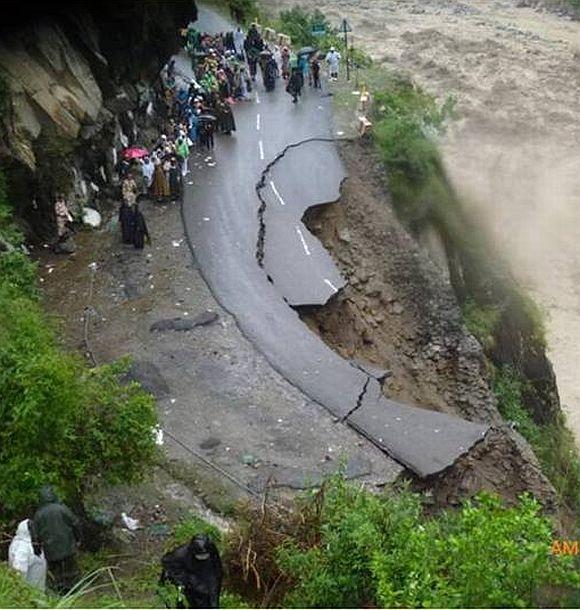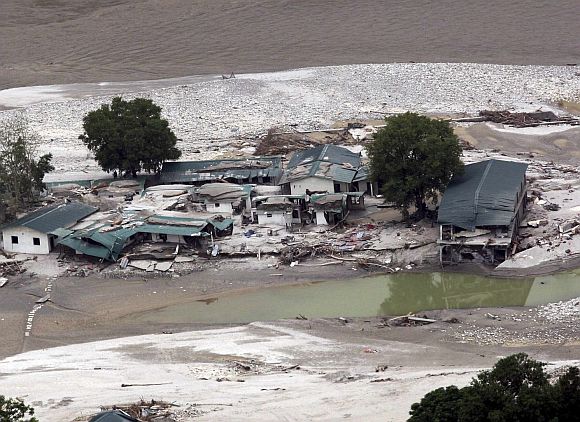 | « Back to article | Print this article |
Post U'khand disaster, respect the vulnerability of the region
The Himalayas have seen unchecked construction activity, illegal mining, unscientific road building and hydropower projects built next to each other. Are we going to learn from this? Asks Sunita Narain
The floods in the Himalayas have been ferocious and deadly. The final body count could run into several thousands. There is no clear estimate of the number of villages wiped out, property destroyed, roads washed away and hydropower projects damaged in the mountain state of Uttarakhand.
The mountains are bleeding and the people have been left battered, bruised and dead.
We know that the Himalayas are the world's youngest mountain range, prone to landslides and flash floods. But what we do not easily comprehend is that two factors have made the already vulnerable region more hazardous. One, climate change-related extreme weather events -- the Indian monsoon has become more intense.
Studies show extreme rain events are becoming more frequent than moderate rain events. Rainfall is also becoming variable and unseasonal. This is what happened in Uttarakhand on that fateful day, June 16.
It rained incessantly; some 200 millimetres poured down within hours at a few places including Kedarnath. It brought down the mighty Himalayas. The rainfall was unseasonal -- June is not considered the beginning of the monsoon season -- and so pilgrims and tourists thronging the region were caught unawares.
Click NEXT to read further...
So, are we going to learn from this?
The disaster was compounded by -- in other words, what made it truly man-made was -- the scale of development intervention in the past decade. This Himalayan region has seen unchecked construction activity, illegal and legal mining, unscientific road building and, of course, hydropower projects built next to each other.
So are we going to learn from this? Or learn how to live with the excesses and shortages of water, particularly in the fragile Himalayan ecosystem? Or learn that extreme rain conditions will require us to build a new water culture?
In 1991, environmentalist Anil Agarwal, after months of research for the publication Flood, Flood Plains and Environmental Myths, brought to attention facts that were considered inconvenient. He wanted to understand why floods occurred with greater intensity in the plains of India.
The general perception was that deforestation in the Himalayas caused floods in the plains, and that planting trees upstream would "fix" the problem. His research showed that the Himalayas were geologically dynamic and prone to landslides, which would in turn block rivers and create natural dams.
The bursting of these dams -- which were made of rubble, stone and silt -- would wreak havoc downstream. He then went on to argue that we needed to consider a Himalayan policy that took into account the fragility and vulnerability of the region.
Click NEXT to read further...
The Himalayas would remain vulnerable to landslides
Road activity had already started to scar the hills, and landslides were increasingly becoming frequent. This, in turn, made it more dangerous for people to live in those areas.
His message was tough: stop blaming the people living in the Himalayas for the floods in the Indo-Gangetic plains. Instead, focus on building a management system to live with floods -- harvest the excess water in ponds, tanks and groundwater recharge systems. It was the willful destruction of the flood plains through unchecked construction of buildings and drainage systems that exacerbated floods.
The Himalayas, he said, would remain vulnerable to landslides and flash floods and development would not work if it did not take into account the true nature of the region. Learn, therefore, to live with the hazards of the Himalayas. The bottom line is that we need to learn to live with nature and not have the temerity to think that we can overcome it.
He had another message a few years later on how we could optimise the use of nature's bounty. In 1997, he published, once again, a seminal volume, Dying Wisdom: Rise, Fall and Potential of India's Traditional Water Harvesting System. It taught us how every region had traditionally devised a unique system of water management, which harvested rainwater and adapted to both the scarcity and excess of it.
Click NEXT to read further...
This is our agenda for survival. Let's learn it fast
The principle was: catch rain where it falls. This system was different from how water bureaucracies functioned -- by centralising water storage and making its distribution through canals and pipelines the responsibility of the irrigation and water agencies.
Agarwal argued, against conventional thinking, that the centralised system would not serve India in the future -- we needed to rebuild our water systems of the past and, in doing so, use modern science and technology to improve it.
As we sadly witness the devastation and loss of lives, Agarwal’s messages hit home. The future will be even more uncertain and riskier because of extreme weather events and mismanagement of resources.
The way ahead is to respect the vulnerability of the region. It cannot be anybody's contention that the Himalayan region must not see development. The question is: how should it develop -- by building roads and hydropower projects or local economies based on tourism, which do not work against nature?
It is also a fact that the change in monsoon patterns will require us to optimise the use of every drop and not allow rain to become devastating floods. Only then will the Himalayan tragedy not be repeated.
This is our agenda for survival. Let's learn it fast.
Monsoon wreaks havoc in Uttarakhand
Click on MORE to see another set of PHOTO features...





